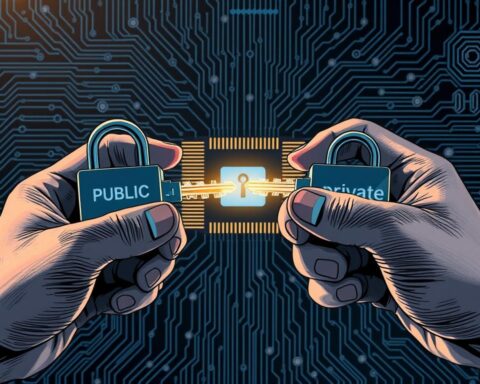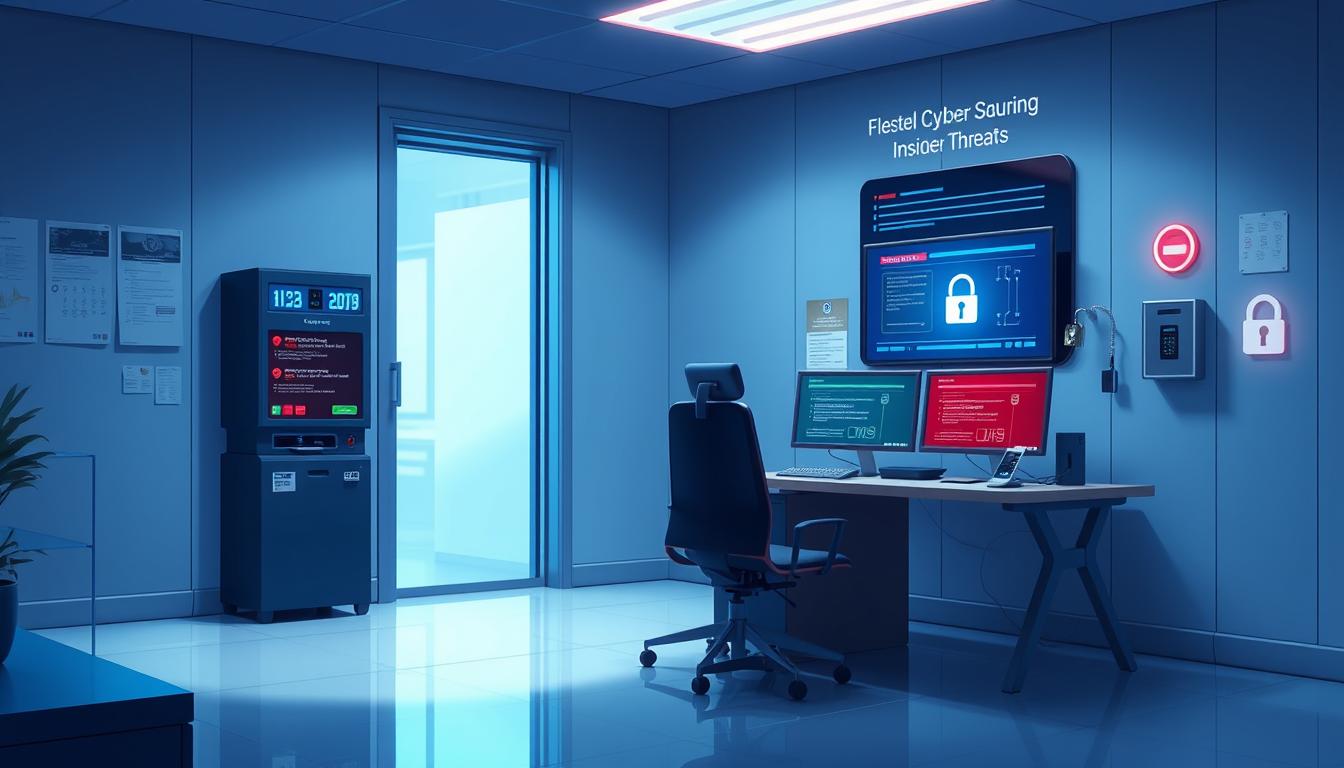Cybersecurity attacks have grown with new security events. Many organizations face data breaches because of weak encryption during online uploads1. A strong cybersecurity foundation is key, combining tech and understanding the human side. It’s a team effort, not just for IT, affecting every decision and training.
Using open Wi-Fi without a VPN increases cyber risks. Older software is easy prey for hackers. Keeping software updated every two weeks is vital1. For more on cybersecurity, check out cybersecurity resources for tips on protecting your data.
Training staff to spot phishing scams is key. Make sure they know how to spot suspicious emails and links. Over 90% of successful hacks start with phishing2. Strong authentication and clear security guidelines are essential to fight threats.
Key Takeaways
- Strengthening your cybersecurity foundation is vital to fight cyber threats.
- Cybersecurity is a team effort, not just IT’s job, needing a proactive approach.
- Strong authentication and clear security guidelines help prevent data breaches.
- Training staff to spot phishing scams is critical to avoid falling victim.
- Regular security checks help find weaknesses and improve data protection.
- Visit what is cybersecurity for more on best practices and strengthening your cybersecurity.
Understanding the Modern Cybersecurity Landscape
The world of cybersecurity is always changing. New threats and weaknesses in digital systems are common. It’s important to prevent cyber threats and use network security solutions to stay safe. Studies show that cyber attacks are getting more complex, with many companies facing these threats every year3.
Human mistakes are a big problem, causing 85% of successful cyber attacks3. Using multi-factor authentication (MFA) can greatly reduce unauthorized access risks3. Cyber attacks can cost a lot, with the average breach costing around $4.45 million3.
Current Cyber Threats and Their Evolution
There are many types of cyber attacks, like malware, ransomware, and phishing. These show how cybersecurity challenges are always changing4. With more people working from home, protecting mobile and endpoint devices is key4. Security experts are using artificial intelligence to spot threats early, showing how technology is helping in this fight4.
Companies that actively look for and manage risks can reduce their exposure by up to 30%3. Good patch management can also help, cutting the risk of cyber attacks by 25% to 40%3. By understanding and addressing these challenges, we can all stay safer from cyber threats.
Essential Components of Strengthening Your Cybersecurity Foundation
To manage cybersecurity risk well, you need to know about key security parts. This includes strong passwords, multi-factor authentication, encryption, and firewalls. These are the basics of keeping your digital world safe.
Core Security Infrastructure Elements
A solid cybersecurity base has several important parts. These are regular updates, change control, and web filters5. Together, they help stop attacks and keep your data safe.
Critical Security Protocols and Standards
Important security rules include multi-factor authentication and regular scans6. The NIST Cybersecurity Framework also helps by giving clear steps to handle risks7.
Building Blocks of Digital Protection
The foundation of digital safety includes training employees and using advanced tech like AI7. By using all these, companies can lower their risk and get stronger6.
By focusing on cybersecurity and using safe practices, companies can fight off cyber threats. This keeps their cybersecurity strong5.
Implementing Robust Authentication Measures
It’s key to have strong authentication for data protection strategies and cyber threat prevention. Studies show that using multi-factor authentication (MFA) can cut down the risk of data breach by 99.9%8. This shows how vital MFA is in stopping cyber threats and keeping data safe.
Using data protection strategies like MFA adds an extra layer of security. It makes it tougher for hackers to get to sensitive data, helping to stop cyber threat prevention9. With MFA, companies can greatly lower the chance of cyber attacks and safeguard their data.
Some good things about strong authentication include:
- Less chance of data being compromised
- Better data protection
- More cyber threat prevention
Companies can also use cybersecurity programs to make their authentication stronger. This helps them protect their data and stop cyber threats. It’s very important for any business8.
Creating and Maintaining Security Policies
Creating strong security guidelines is key for companies to keep their data safe from cyber threats. They need to use it security fundamentals and network security solutions to protect their systems. A good company does risk assessments, plans for future attacks, and updates its security after a breach, as cybersecurity policies suggest10.
Many companies don’t have clear rules for when employees break security rules10. To fix this, companies should make clear cybersecurity best practices and train employees often. They can use workshops, seminars, and online courses to teach the value of security and how to stop breaches. Training employees well and doing regular security checks are important, as shown by the focus on security-conscious engineers and “Remediation Days”11.
It’s vital to do regular security checks to find and fix weak spots in systems. This includes penetration testing, risk assessments, and incident response services. By doing these things, companies can keep their systems and data safe and follow strong it security fundamentals and network security solutions12.

- Developing detailed security guidelines
- Training and educating employees
- Doing regular security checks and assessments
By taking these steps, companies can protect their systems and data well. They can also follow strong cybersecurity best practices10.
Advanced Security Technologies and Tools
As we explore the complex world of cybersecurity, using advanced tools is key. Recent data shows 93% of organizations faced two or more identity breaches last year13. This underlines the need for strong security measures. Google Workspace, for example, has a 99% success rate in stopping threats like spam and phishing14.
Tools like Virtru help by encrypting data and controlling access14. The average cost of a data breach is $4.45 million14. It’s vital for companies to invest in top-notch security tools. This way, we can lower the risk of data breaches and keep online practices safe.
Effective security strategies include classifying data into three levels: restricted, private, and public13. Tools like Pure Storage’s SafeMode create snapshots that ransomware can’t touch13. By using these advanced tools, we can fortify our cybersecurity and fight off new threats.
For more on cybersecurity best practices, check out cyber hygiene daily habits for staying safe online. By focusing on cybersecurity risk management and secure online practices, we can lessen data breach risks. This ensures a safer online space for everyone.
Conclusion: Maintaining Long-term Cybersecurity Resilience
Understanding that strengthening your cybersecurity foundation is a continuous effort is key. It demands a proactive stance, always updating your skills to counter new threats15. With data storage growing exponentially, it’s vital to adjust security measures to handle cyber risks15.
For companies relying on IT, cyber threats are a major concern15. So, it’s essential to have strong information security measures in place. This helps in managing risks and staying competitive in the market15.
It can take months or even years for organizations to apply software patches16. This shows the importance of ongoing learning in cybersecurity. By focusing on strengthening your cybersecurity foundation and keeping up with new threats, we can protect ourselves better.
To keep cybersecurity strong over time, we must commit to information security measures and stay proactive. By working together, we can make the digital world safer for all15.
FAQ
What is the importance of strengthening your cybersecurity foundation?
Strengthening your cybersecurity foundation is key to protecting your digital assets. It’s about understanding the human side of cybersecurity. It also means using strong cybersecurity practices and data protection to stop cyber attacks.
What are the current cyber threats and how have they evolved?
Today’s cyber threats include phishing, ransomware, and malware. These threats have grown more complex and targeted. It’s important to use cyber threat prevention and network security to fight them. Knowing IT security basics is also critical.
What are the essential components of a strong cybersecurity foundation?
A strong cybersecurity foundation includes core security elements, key protocols, and digital protection basics. These parts work together for full security. They can be put into action through cybersecurity risk management and secure online habits.
How can robust authentication measures enhance cybersecurity?
Strong authentication, like MFA, boosts cybersecurity by stopping threats and protecting data. This is key against new cyber threats. Keeping data safe should be a top goal for companies.
What is the importance of creating and maintaining security policies?
Having and keeping security policies is vital for an organization’s security. It means making detailed guidelines, training employees, and doing regular security checks. IT security and network solutions are key to strong policies and good cybersecurity practices.
How can advanced security technologies and tools aid in cybersecurity risk management?
Advanced security tech, like AI and machine learning, helps manage risks by spotting threats fast. These tools also support safe online habits. They help companies keep up with new cyber threats.
What is the key to maintaining long-term cybersecurity resilience?
To keep cybersecurity strong over time, be proactive. Always update your knowledge and practices to beat new threats. This means being dedicated to security and keeping your foundation strong through ongoing risk management and safe online habits.
Source Links
- 5 Helpful Tips To Avoid Cyberattacks At Your Workplace – https://www.linkedin.com/pulse/5-helpful-tips-avoid-cyberattacks-your-workplace-omer-rana
- Phishing Campaign To Stop Email Fraud From KnowBe4 And Cybercrime Magazine – https://cybersecurityventures.com/phishing-campaign/
- Cyber Risk Mitigation: Building a Resilient Cybersecurity Foundation – https://blog.riskrecon.com/cyber-risk-mitigation-building-a-resilient-cybersecurity-foundation
- What Is Cybersecurity? The Realities of the Digital Age – https://www.apu.apus.edu/area-of-study/information-technology/resources/what-is-cybersecurity-the-realities-of-the-digital-age/
- 18 Foundational Cybersecurity Measures Businesses Need in 2025 | VC3 – https://www.vc3.com/blog/foundational-cyber-security-measures
- From Reactive to Proactive: Essential Foundations for a Cybersecurity Program in 2025 – https://www.optiv.com/insights/discover/blog/how-to-enhance-cybersecurity-program
- How to build a strong cybersecurity foundation – https://networkdigitalsecurity.com/1-building-a-strong-foundation-the-key-to-effective-cybersecurity-for-your-organization/
- Strengthening Your Business with Robust Cybersecurity Measures – https://giraffestudioapps.com/cybersecurity-for-businesses-63/
- IT Asset Management for a Strong Cybersecurity Posture | Lansweeper – https://www.lansweeper.com/blog/cybersecurity/strengthen-your-cybersecurity-posture-with-it-asset-management/
- Building a Strong Cybersecurity Foundation: People, Processes, and Technology – https://www.infopercept.com/blogs/building-a-strong-cybersecurity-foundation
- How to develop an effective information security policy – https://www.powerdms.com/policy-learning-center/how-to-develop-an-effective-information-security-policy
- How To Plan & Develop An Effective Cybersecurity Strategy – https://purplesec.us/learn/cybersecurity-strategy/
- Improve Cybersecurity Foundations – https://corebts.com/blog/strengthen-cybersecurity-foundations-in-an-the-age-of-ai/
- 12 Cybersecurity Essentials: Build a Secure Foundation for Your Business – The Wursta Corporation – https://wursta.com/12-cybersecurity-essentials-build-a-secure-foundation-for-your-business/
- Resilience in the Context of Cyber Security: A Review of the Fundamental Concepts and Relevance – https://www.mdpi.com/2076-3417/14/5/2116
- Protecting Information with Cybersecurity – PMC – https://pmc.ncbi.nlm.nih.gov/articles/PMC7122347/










